Using Resistors In Guitars – 101
When you think of tone shaping, a couple of items might come to mind. We all use pickups, capacitors (tone caps), and pots as tone shapers. However, using Resistors in […]


Imagine this heartbreaking scenario: you just purchased a Bridge pickup for your guitar. You’re excited to throw it in and rock out, so you get it installed and plug it in. The pickup sounds great on its own, but when you combine the Bridge with the Middle pickup, it sounds like crap! It seems thin, hollow, and weak. What happened? What went wrong?
Your Bridge pickup is out of phase with the rest of your pickups. Now, you have to take it out, send it back to us, and pay for shipping again to get it back in phase with your other pickups. Not cool. If you had known about pickup polarity beforehand, you would have avoided this issue altogether.
Fear not! We are here to educate you – we want to make you an expert on Pickup Polarity so you can avoid these pesky problems in the future. So, if that sounds like something you want to avoid, read on!
When you play an electric guitar, your guitar pickups create a voltage that get sent to the amplifier and then to the speaker. The signal you create is like a sine wave – and the wave can either “push” or “pull” on the speaker.
In reality, there are a few things that contribute to the overall polarity of your guitar’s pickup: Magnet Polarity and Coil Direction (or Wind Direction). A magnet can only be either North or South, and the Coil Direction can either be clockwise or counter-clockwise (don’t worry, we’ll explain these further).
The ideal situation is to have your pickup In-Phase and Hum-Cancelling with other pickups. You’ve probably heard the term “Reverse Wound / Reverse Polarity” (RWRP) – well, that’s what we’re talking about. We’re talking about an In-Phase and Hum-Cancelling set or pair of pickups. There are four important considerations when making a pickup. Let’s break them down:
Now that we’ve discussed what polarity is, let’s break down how you can find your own pickup’s polarity so you can avoid mixing out-of-phase pickups in the future. This may seem a little daunting, but with the right tools and our handy guide, you’ll be able to identify your pickup’s polarity in no time!
Learn this essential skill – if you ever plan on replacing a single pickup in a guitar, this skill is invaluable to learn.
Magnet Polarity is super important – unlike coil direction, you cannot easily reverse it if things are out of phase. At the shop, we can magnetize a pickup any way, easily – it’s much harder to do after the pickup has been made, depending on the style.
Your pickups either have North or South aimed at your strings. If you have a compass, it’s easy to do: hold the compass on top of your pickup, on its side. This will allow you to observe which way the compass pulls.
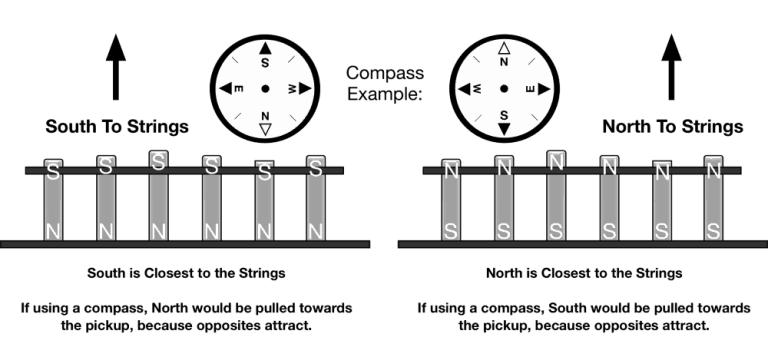
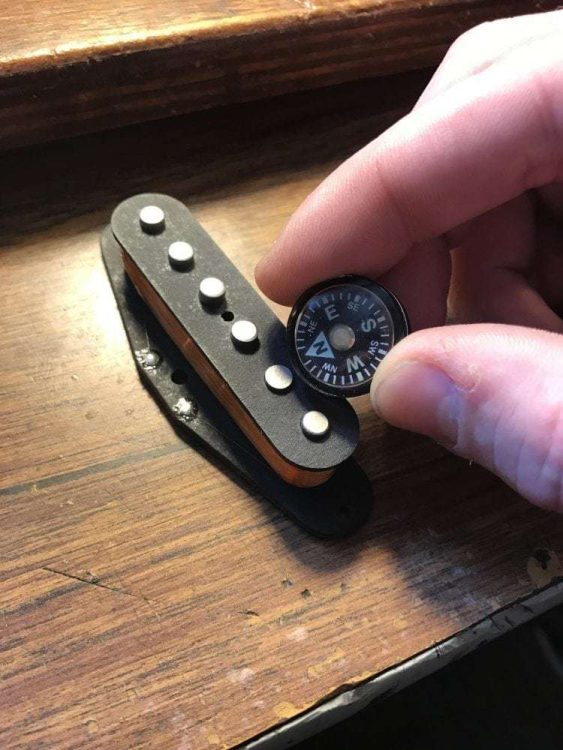
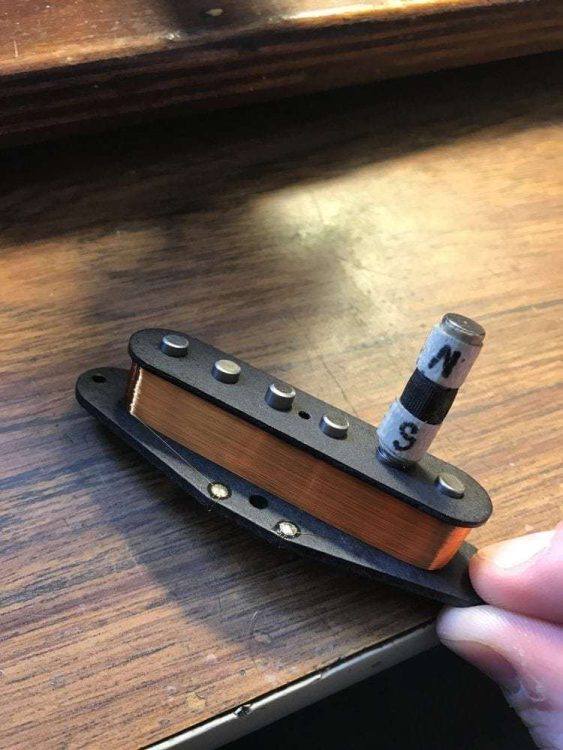
On single coil pickups, coil direction is an essential part of pickup polarity. Learn how to identify it here.
When we wind a pickup, we wind it one of two ways – “clockwise from ground to hot”, or “counter-clockwise from ground to hot”. Here’s what that looks like:
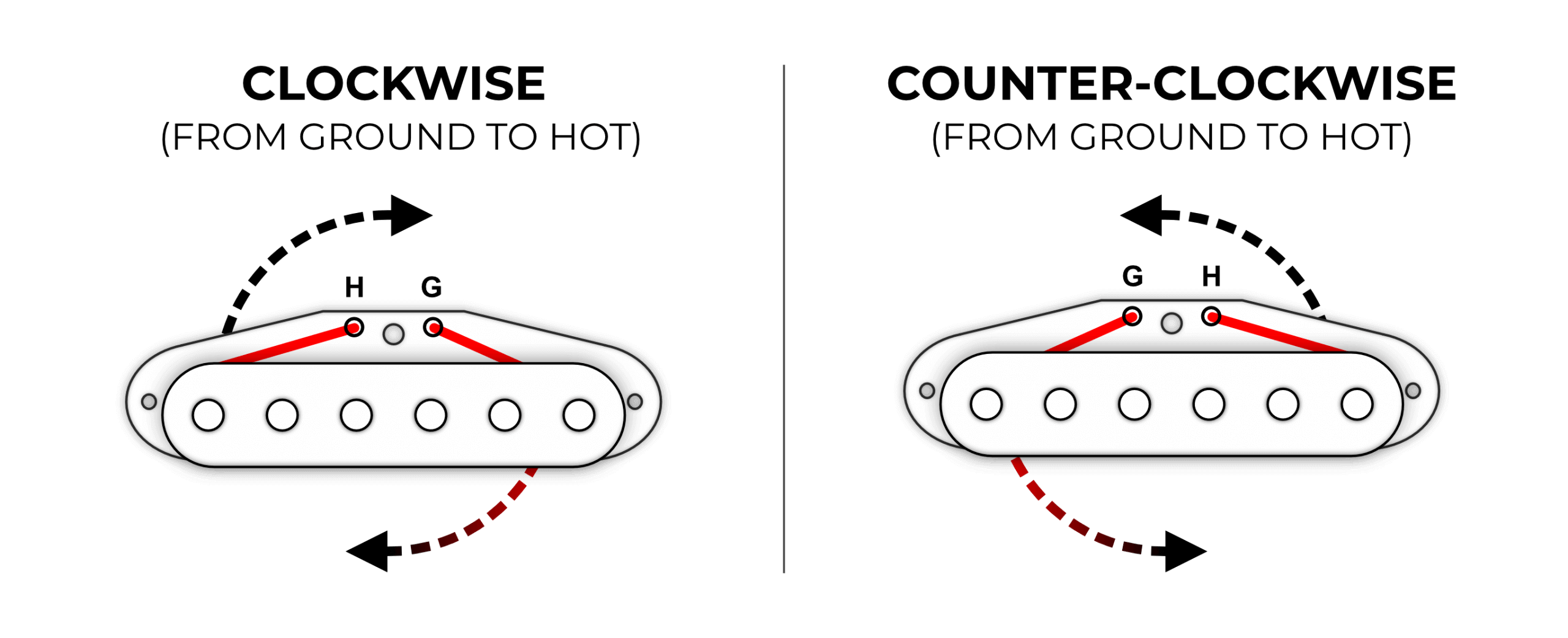
Illustrated above is where the coil starts and ends. As you can see, the coil starts on the left on Bottom To Winder, and on the right with a Top to Winder pickup.
The Start of the coil is always shown by our Black lead, and the last turn is denoted by our White lead. For a real-world example, see below:
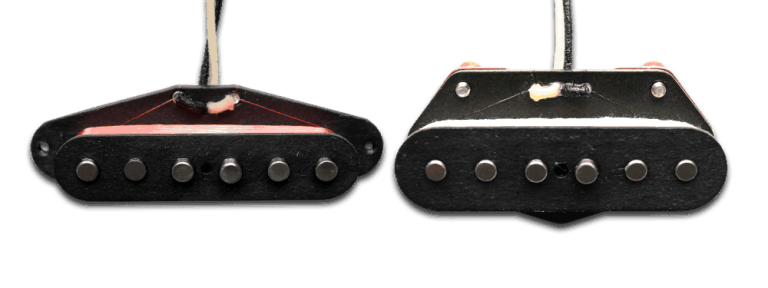
In the above image, the Strat Pickup on the left was wound counter-clockwise from Ground to Hot. The Tele Bridge on the right has a clockwise coil direction, from Ground to Hot.
The best thing to do here is to pull your pickup out and look at it. Use the above image to reference what direction your coil was wound.
Send us a picture of the pickup out of the guitar. If we can see the leads, we can denote the coil direction
Check with your manufacturer, or do a quick search on the internet for your exact model. This is not always the best case because there is not a lot of consistency throughout the industry.
Let’s put all of the concepts of Pickup Polarity together with a common example: Stratocaster wiring. With Stratocaster pickups, positions 2 & 4 of the 5-way switch are both in-phase and hum-cancelling.
When the Bridge and the Middle pickup combine, their coil directions and their magnetic orientations reverse. This cancels hum and keeps pickups in phase:
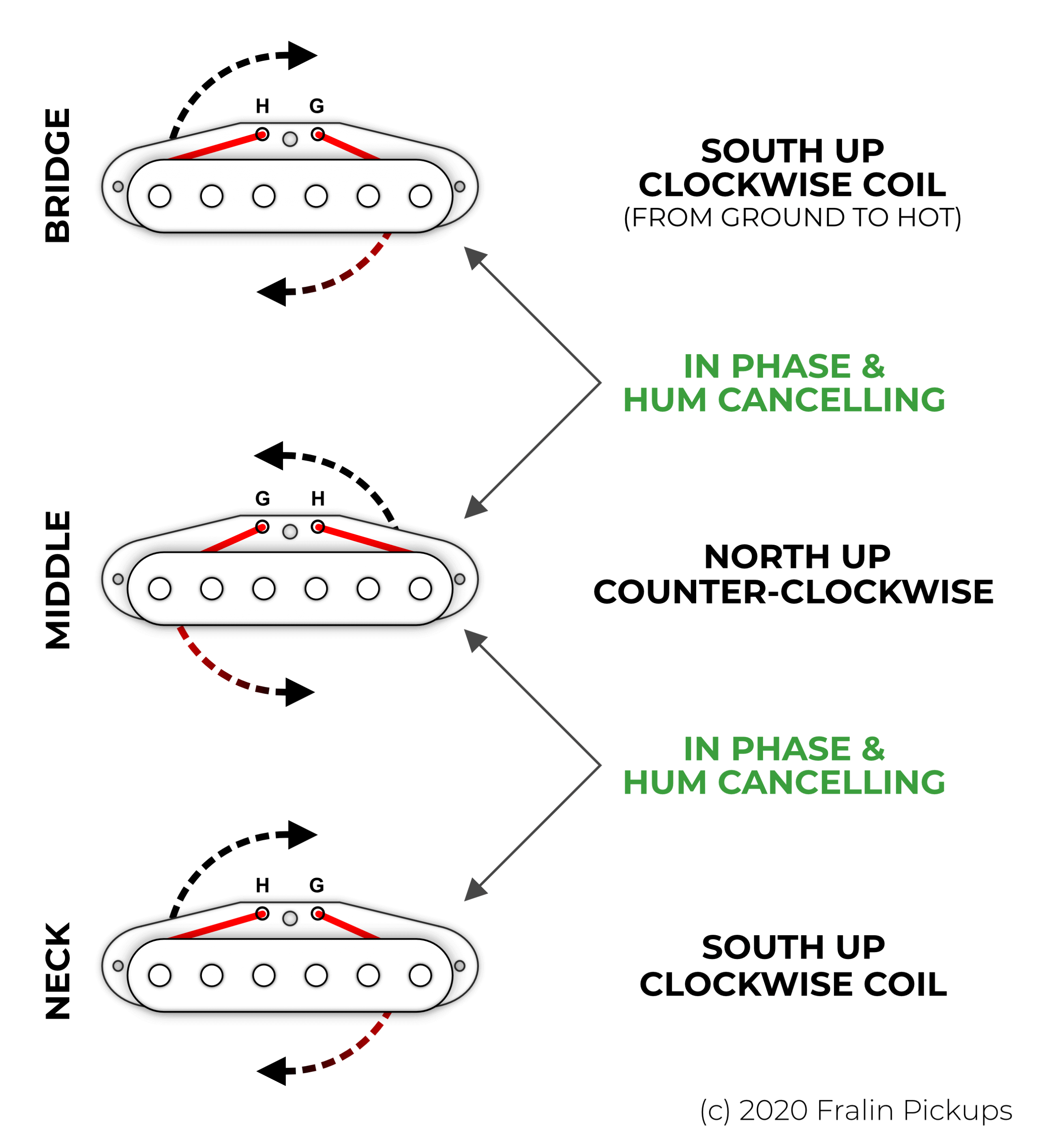
The same applies for virtually any instrument that uses Single Coil pickups: Telecasters, Jazz Basses, Mustangs, and Jazzmasters…the list goes on.
If your pickups are out of phase, you might be able to fix it yourself. You can try to reverse the coil direction, for example. However, reversing only one “attribute” of a pickup can cause some unintended side-effects. Here are some potential problems, and how to diagnose them:
Hum-cancelling pickups are a little easier to identify, as one part of the puzzle is already given to us. A Humbucker (this can be our hum-canceling P-90’s, Hum-Cancelling Jazzmasters, Split Blades, etc.) has both magnetic directions already. So, you don’t need to worry about Magnetic Orientation. What you do need to know is Coil Direction. This is really easy – just order your pickup with Multiple Leads, or, your can reverse your coil direction by flipping the leads:

As you can see, Polarity can be a little confusing. We hope this helps break it down. If you have any questions, give us a call! We’ll do our best to help.
80 Comments For This Post
Want to chime in to the conversation? Please do so! Please respect others.
Hi,
Newby, just wired up my first bass. P (so split coil) and a STACKED double coil J on a blend pot. Severe phase problems when both P and J active, very weak signal.
Dont think swapping wires helped, no idea about the winding. So repolarise the stacked J is the best option here?
Thanks for you time!
You should be able to reverse the phase of this by reversing one of the pickups leads – did you reverse both, per chance?
Hi, I bought a P90 for a TV Jones neck to put on my Gretsch Gretsch G5230t. It sounds great, I like the sound, but the problem is that it has noise. It has a shield but it came tangled up to connect it along with the black cable. Any suggestions to fix the noise?
Hey Sebastian, is the noise you’re facing regular 60-cycle hum, or is it a grounding issue?
More information here: Help! I’m getting a buzz!
Recently I put a ’51 Nocaster in the bridge of my player series strat (For context, I upgraded the bridge and middle pickups to Lollar ’64s.) I just checked the polarity and the Lollar Neck and the Nocaster are both North wound and the Middle is south. My question then is: Why is my middle + neck position sounding dry, out-of-phase and lifeless?
Thank you for the information already provided!
If you converted a Telecaster to a Nashville Tele, you are probably experiencing what we call the Nashville Tele Problem. The magnet polarity might be correct, but the coil direction might be the culprit there. If both coil directions are the same on your Middle and Neck pickup, they would be out of phase.
As I thought, if your pickup attracts the north side (usually red) of a compass needle, then your pick is south to strings. Unfortunately, not all pickup manufacturers agree – some follow the idea that if your pickup attracts the north direction of the compass then it’s North to strings. This can make ordering single pickups tricky, if you don’t know which way the the maker assesses polarity!
What about a single bridge humbucker, with mixed magnets.. For example, having one traditional sized Alnico V magnet in between the coils, but in place of a “spacer”, there’s a thin Ceramic 8 magnet on one end?
In this case, especially without a neck pickup, should both magnets face the same direction, face each other, or face away from each other?
Then.. What if there was a 2nd Ceramic “spacer” magnet on the other end as well? Would that change anything?
Thanks!
I’m working on a G&L Strat that is:
Neck N CCW
Middle S CW
Bridge N CCW
And I’d like to install an Expander Switch that connects the Neck and Bridge pickups so the selector switch goes like this:
1 is by the Bridge pickup.
1 is Neck and Bridge
2 is all three pickups
3 is Middle
4 is all three pickups
5 is Neck and Bridge
I expect to lose output on positions 2 and 4. How can I avoid that?
Any other comments?
Joe.
Hey Joe, sorry for the delayed response on this – I’m not sure how you can avoid losing output when you put all three pickups in Parallel. That’s kind of the nature of Parallel wiring. If anyone else has ideas on this, feel free to chime in!
Thank you for this information! If I remove the middle pickup from a Strat, should I actually swap the middle pickup with one of the other two to keep the N-S polarities, rather than just removing the middle which leaves two pickups with the same polarity, even though they’re spaced much further apart?
Hey Michael, yes – that’s correct!
Hello,
May I please have information about what would be the scenario if the pickups put all together as below?
Would it work efficiently in terms of “ in phase & hum cancelling “ ?
Bridge – north up & cw
Middle – south up & ccw
Neck – north up & cw
Thank you very much,
Best regards
Hello,
First of all I would like to thank you for the great information you’ve given.
As it is shown in your diagram and depending on it, is it also possible to put all pickups together as below and would they work like this? ( i mean in phase & hum cancelling )
1. Pickup – north up and cw
2. Pickup – south up and ccw
3. Pickup – north up and cw
And if you have any information about the pickups’ standard polarity and wound directions below, would you please share it with me? So that I can put them all together without having any problems.
Seymour Duncan SSL – 5
Fender custom shop 69
Fender custom shop fat 50’s
Thank you very much,
Best regards,
Hey Levent, based on my research, I do not believe this set will work. I believe you’ll have phasing issues in both middle positions.
So I can get my head wrapped around these concepts, If I were to consider just a single pickup at the bridge, NO other pickups whatsoever, does north/south orientation, or coil wind direction effect the tone or amplitude at all?
Are the north/south poles and winding direction only have to do with connection to additional pickups for phase reasons?